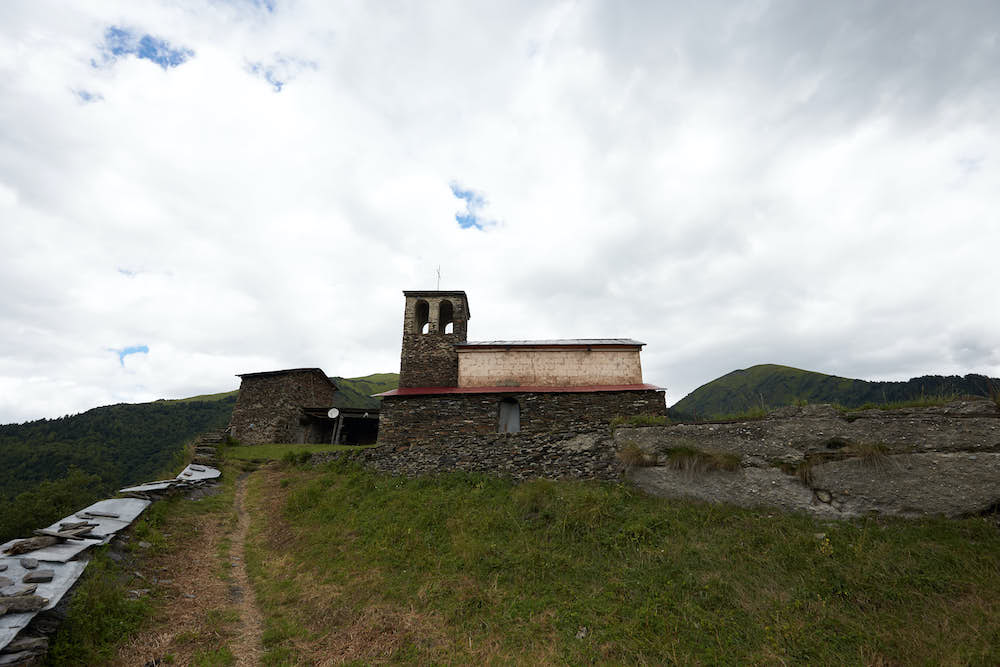
Feel free to add tags, names, dates or anything you are looking for
The Church of St. Cyricus and Julitta, known as Lagurka, is the most venerated church in Upper Svaneti (a mountainous north-western region of Georgia). July 28th, the commemoration day of the Holy Martyrs St. Cyricus and St. Julitta, is one of the main religious feasts in Svaneti, and is celebrated every year at Lagurka Church. The locals call this feast Kvirikoba (the day of St. Cyricus).
Lagurka Church is located atop a high cliff on the left bank of the Enguri River, near the village Khe in the community of Kala. A narrow path leads up to the church. A breathtaking panoramic view overlooking the mountains and vast valley opens up from the courtyard of the church.
Similar to other churches of the region, Lagurka Church (10th c.) is a relatively small (5 x 2.70 m) and simple structure. It is single-nave edifice with the apse to the east and the annex to the south; the bell-tower on its western side is a later addition.

Church of St Cyricus and St Julitta (Lagurka)
Lagurka Church is one of three churches in the region that were painted by the King’s painter (Royal Painter), Tevdore. This fact is evidenced by the Georgian inscription above the western door. The text of the inscription is similar to the inscriptions on the other two murals by Tevdore (Iprari,1096, and Nakipari,1130). It provides information about the donors - the Aznauri (lower feudal) of Khevi (valley), the name and title of the painter (the ‘King’s painter Tevdore’), and the exact date that the wall paintings were executed (1111). Hence, Lagurka is the second church that was painted by Tevdore.
Church of St. Cyricus and St Julitta (Lagurka). West wall.
As in the case of the Iprari and Nakipari murals, the Christological cycle at Lagurka is also limited, with preference given to representations of the individual saints and patron saints of the church. The murals in the nave are divided into two zones: the vault is taken up with four scenes symmetrically disposed – the Nativity and the Crucifixion to the south, and the Baptism and the Anastasis to the north.
Church of St. Cyricus and St Julitta (Lagurka). Vault.
The lower registers of the southern and northern walls are decorated with blind arches, and each of them bears a single composition. The Martyrdom of St. Cyricus and St. Julitta are depicted in the arches of the southern wall, while St. George and St. Theodore are portrayed on horseback in the arches of the northern wall.
Martyrdom of St. Cyricus and St. Julitta
.jpg)
St. Theodore
The west wall is assigned to frontal figures of the Holy Martyrs: St. Cyrius and St. Julitta are depicted in the upper zone, and St. Barbara and St. Catherine on either side of the door. The murals of the sanctuary apse follow the established iconographic program of apse decoration among the churches of Svaneti. It is composed of the Deesis, the Apostles and Holy Bishops (the murals of the apse were restored in the 17th c). The chancel barrier features bust images of St. Stephanos, St. Cyricus, St. Julitta and St. Christina.
Church of St. Cyrius and St. Julitta. View to the east.
As mentioned above, the church’s patron saints are particularly accentuated in the iconographic program of the murals. Besides their portraits, there are also scenes of the martyrdom of St. Cyricus and St. Julitta.
Beheading of St. Julitta
The inclusion of scenes from the lives of St. Cyricus and St. Julitta makes the Lagurka murals exceptional, since there is no other monument in Georgia that shows such episodes from the lives of these saints.
The choice of the compositions was obviously inspired by the titular saints of the church, as well as by the cult of St. Cyricus and St Julitta in this particular region of Georgia.
The strictly organized arrangement of the murals, the distribution of the compositions in accordance with the church’s interior architectural structure, the domination of strong figures over the architectural and landscape backgrounds, and the restrained and balanced coloring all enhance the monumental character of these murals. Tevdore’s style is notable for his linear treatment of the figures, the powerful and dynamic design, and the emotional expressiveness of the images.
Along with the outstanding murals produced ‘by the hand of the King’s painter Tevdore,’ Lagurka Church also houses an excellent collection of artifacts: painted as well as metal icons dating from the 10th to the 14th centuries. A monumental, chased pre-altar cross still stands in its original place before the chancel barrier. One of the most remarkable objects kept in the church is a Byzantine reliquary – the so called ‘Shaliani Icon’ (12th c.).